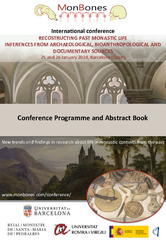Приказ основних података о документу
Cervid Representations in the Iconography of Medieval Serbia
| dc.contributor | Lloveras, Lluís | |
| dc.contributor | Rissech, Carme | |
| dc.contributor | Nadal, Jordi | |
| dc.contributor | Castellano, Anna | |
| dc.contributor | Jové Sans, Montserrat | |
| dc.creator | Vranić, Mirko | |
| dc.creator | Mladenović, Teodora | |
| dc.creator | Kajtez, Irina | |
| dc.date.accessioned | 2024-02-28T14:04:52Z | |
| dc.date.available | 2024-02-28T14:04:52Z | |
| dc.date.issued | 2024 | |
| dc.identifier.uri | http://reff.f.bg.ac.rs/handle/123456789/6238 | |
| dc.description.abstract | Abundant evidence indicates that cervids (red deer, fallow deer, and roe deer) have played a significant role in the daily lives of people since prehistoric times. Traces of their presence, as one of the most common and widespread game in the Balkan region, are discernible in archaeological and archaeozoological records, historical sources, toponymy, and iconography across various epochs. Following the tradition of ancient Christian art, Serbian medieval culture incorporated the symbolism of cervid from interpretations of the Old Testament texts. This symbolism was expressed through diverse forms – within the funerary practice as the sculptural decorations and engravings on tombstones, carvings on church walls, bricks, jewellery, and other artefacts. The depicted representations often feature an individual cervid or group of them, frequently set within hunting scenes. Although the images of cervids are quite similar in the manner of their appearance, their presence on sites is quite scarce. In medieval Serbia, they are most usually found in (and on) churches, monasteries, and tombstones, which strongly associates them with the religious aspects of life and the afterlife. Interestingly, the majority of these representations had been carved subsequently on frescoes and other architectural elements on the inner and outer walls of churches. This paper presents the currently known and recently uncovered representations of cervids from the monastery complexes and churches on the territory of medieval Serbia. The special reference refers to their spatial and temporal distribution, as well as the manner of their representation. The aim of this comprehensive study is a better understanding of this interesting phenomenon within the context of their appearance. | sr |
| dc.language.iso | en | sr |
| dc.publisher | Barcelona: University of Barcelona | sr |
| dc.publisher | Tarragona: University Rovira i Virgili | sr |
| dc.publisher | Barcelona: Royal Monastery of Santa Maria de Pedralbes | sr |
| dc.relation | info:eu-repo/grantAgreement/ScienceFundRS/Ideje/7750265/RS// | sr |
| dc.rights | openAccess | sr |
| dc.rights.uri | https://creativecommons.org/licenses/by/4.0/ | |
| dc.source | MonBones – Reconstructing Past Monastic Life. Inferences from Archaeological, Bioanthropological and Documentary Perspectives, 25-26th January, Barcelona, Spain | sr |
| dc.subject | iconography | sr |
| dc.subject | medieval Serbia | sr |
| dc.subject | cervids | sr |
| dc.subject | church | sr |
| dc.subject | carvings | sr |
| dc.subject | monastery | sr |
| dc.title | Cervid Representations in the Iconography of Medieval Serbia | sr |
| dc.type | conferenceObject | sr |
| dc.rights.license | BY | sr |
| dc.citation.epage | 68 | |
| dc.citation.spage | 68 | |
| dc.identifier.fulltext | http://reff.f.bg.ac.rs/bitstream/id/15620/MonBones2024Vranicetal.pdf | |
| dc.identifier.rcub | https://hdl.handle.net/21.15107/rcub_reff_6238 | |
| dc.type.version | publishedVersion | sr |

